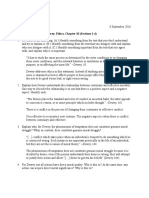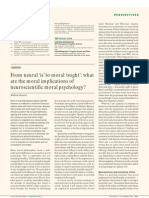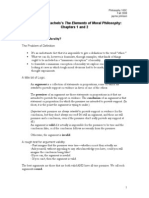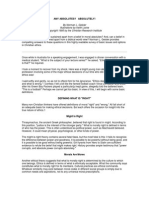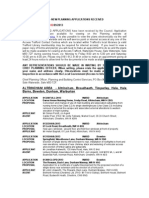0%(2)0% found this document useful (2 votes)
782 viewsMorality Quiz
Morality Quiz
Uploaded by
888pineappleThis document contains 20 multiple choice questions about moral philosophy and theories such as consequentialism, deontology, and the views of philosophers like Kant, Bentham, Mill, and Haidt. The questions cover topics like the trolley problem, the categorical imperative, the difference between act and rule utilitarianism, and studies on the effects of emotion and bodily focus on moral judgment.
Copyright:
© All Rights Reserved
Available Formats
Download as DOC, PDF, TXT or read online from Scribd
Morality Quiz
Morality Quiz
Uploaded by
888pineapple0%(2)0% found this document useful (2 votes)
782 views3 pagesThis document contains 20 multiple choice questions about moral philosophy and theories such as consequentialism, deontology, and the views of philosophers like Kant, Bentham, Mill, and Haidt. The questions cover topics like the trolley problem, the categorical imperative, the difference between act and rule utilitarianism, and studies on the effects of emotion and bodily focus on moral judgment.
Original Description:
Social Science
Copyright
© © All Rights Reserved
Available Formats
DOC, PDF, TXT or read online from Scribd
Share this document
Did you find this document useful?
Is this content inappropriate?
This document contains 20 multiple choice questions about moral philosophy and theories such as consequentialism, deontology, and the views of philosophers like Kant, Bentham, Mill, and Haidt. The questions cover topics like the trolley problem, the categorical imperative, the difference between act and rule utilitarianism, and studies on the effects of emotion and bodily focus on moral judgment.
Copyright:
© All Rights Reserved
Available Formats
Download as DOC, PDF, TXT or read online from Scribd
Download as doc, pdf, or txt
0%(2)0% found this document useful (2 votes)
782 views3 pagesMorality Quiz
Morality Quiz
Uploaded by
888pineappleThis document contains 20 multiple choice questions about moral philosophy and theories such as consequentialism, deontology, and the views of philosophers like Kant, Bentham, Mill, and Haidt. The questions cover topics like the trolley problem, the categorical imperative, the difference between act and rule utilitarianism, and studies on the effects of emotion and bodily focus on moral judgment.
Copyright:
© All Rights Reserved
Available Formats
Download as DOC, PDF, TXT or read online from Scribd
Download as doc, pdf, or txt
You are on page 1of 3
Question 2
The consequentialist approach to moral philosophy is most strongly associated with:
Immanuel Kant
Jonathan Haidt
Jeremy Bentham
Plato
Question 3
Which of the following is a challenge that has been raised against consequentialist moral
theories?
The universal rules they rely on are refections of arbitrary biases.
They lead to conclusions that seem deeply wrong, such as being morally required to
smother a child to save fve other people.
Both of the above.
Question 4
Kants Categorical Imperative states that the right thing to do is:
the act that would maximize the pleasure of everyone involved.
the act that is appropriate given your culture.
the act that you would want to have as a universal law
the act that has the best consequences.
Question 5
When given the Bridge condition in the trolley scenario, people tend to say that you
shouldnt kill one person in order to save fve people. This is inconsistent with the view that
our moral reasoning is governed by:
Consequentialist intuitions.
Deontological intuitions.
Emotion.
Both consequentialist and deontological intuitions
Question 6
Suppose someone had severe brain damage in his frontal lobe and could no longer feel
emotions. Based on the fMRI data of Josh Greene and colleagues, how is he most likely to
respond to the switch versus bridge case?
He would throw the switch but not push the man of the bridge.
He would push the man of the bridge but not throw the switch.
He would throw the switch and push the man of the bridge.
He would not throw the switch and would not push the man of the bridge.
Question 7
The doctrine of double efect explains our intuitions about the bridge case by claiming:
It is always immoral to cause someone harm using your own hands.
It is always immoral to cause someone harm in order to bring about a good action.
Pushing a man with ones own hands is emotional; pulling a switch is not.
Pushing the man has two efects; pulling the switch has one efect.
Question 8
A study discussed in lecture looked at moral judgments of people whose bodies were more
or less visible. This study found:
Focusing on someones body makes you worry less about causing the person pain,
and makes you see the person as less agentic
Focusing on someones body makes you worry more about causing the person pain,
and makes you see the person as more agentic
Focusing on someones body makes you worry less about causing the person pain,
and makes you see the person as more agentic
Focusing on someones body makes you worry more about causing the person pain,
and makes you see the person as less agentic
Question 9
In lecture, we discussed a study by Ariely and Lowenstein in which male participants
answered questions while either sexually aroused or not aroused. One main conclusion of
this study was:
Men claim to be more willing to participate in immoral behavior when they are
aroused.
Men become more consequentialist (and less deontological) when aroused.
Men become more deontological (and less consequentialist) when aroused.
Men who are aroused are more likely to help strangersbut only female strangers.
Question 10
What is the one diference between the views of Haidt and Harris, as represented in their
TED talks?
Harris believes that morality is innate; Haidt believes that morality is learned.
Harris believes that we are morally similar to nonhuman primates; Haidt believes
that we are very diferent.
Haidt believes that we should respect most major moral perspectives; Harris
believes that some of them are just mistaken.
Haidt argues for utilitarianism; Haidt argues against utilitariansim.
Question 11
The view of morality that Harris presents in his TED talk is most similar to that of:
Immanuel Kant
John Stuart Mill
David Hume
Elizabeth Anscombe
Question 12
Harris uses the analogy of __________ to show that although a concept is difcult to defne
and subject to revision does not make it meaningless.
physical health
political afliation
religion
Question 13
In his TED talk, Haidt argues that:
The great conservative insight is that order is difcult to achieve.
Punishment is essential to promote cooperation in large groups.
Both of the above.
None of the above.
Question 14
Pinker argues that the moral reputations of Mother Teresa, Bill Gates, and Norman Borlaug
dont match up with the good they have done. Pinker concludes that this shows that people
are:
infuenced by consequentialism.
vulnerable to moral illusions.
subject to moral contamination.
believers in the conservation of moralization.
Question 15
Pinker hypothesizes that there is a Law of Conservation of Moralization, by which he
means:
People who are politically conservative tend to have stronger moral views.
Once an act has been judged as immoral, it tends to remain that way.
As some old behaviors are taken out of the moral realm, new behaviors are added
to the moral realm.
A persons moral views tend to become more conservative over time.
Question 16
Jonathan Haidt argues that people arrive at moral judgments by reasoning about the
harmful consequences of an act. True or False?
True.
False.
Question 17
Which of the following actions is most compatible with a deontological moral view?
Dropping an atomic bomb that kills many innocent people, but ends a war that would
kill many more.
Hiding an innocent person from a murderer by lying to the murderer about the
persons whereabouts.
Refusing to smother a baby, even though its cries will reveal your hiding place and
lead to the death of many others.
Borrowing money and not repaying it.
Question 18
In the lectures by Tamar Gendler, she discusses four justifcations for moral theories, and
claims that utilitarianism is based on __________ while deontology is based on _________.
goodness; rightness
rightness; goodness
virtuousness; rightness
goodness; divine mandate
Question 19
He who saves another creature from drowning does what is morally right whether his
motive be duty or the hope of being paid for his trouble. This quote best represents the
view of:
Immanuel Kant
Aristotle
John Stuart Mill
all of the above
Question 20
Kants view is that an act should only be considered moral if it is done:
because of a sense of duty
because the actor wants to do it
because it has the best consequences
because it is in the actor's own best interests
You might also like
- Moving Truck Rental ReceiptDocument3 pagesMoving Truck Rental ReceiptAcieffe Roxia100% (15)
- The Greatest Ethical Ideal That I Learned From This SubjectDocument4 pagesThe Greatest Ethical Ideal That I Learned From This SubjectAcyl Chloride Hariprem0% (1)
- Normative Theory of Business EthicsDocument7 pagesNormative Theory of Business EthicsHannah frances RabulanNo ratings yet
- Notes of Voicelessness For Piano, Beat FurrerDocument9 pagesNotes of Voicelessness For Piano, Beat FurrerLuiz Vinoza100% (2)
- Ken More 48102 Tech SheetDocument12 pagesKen More 48102 Tech Sheetahman0No ratings yet
- Jonathan Haidt:: Biological Theory of MoralityDocument75 pagesJonathan Haidt:: Biological Theory of MoralityQwertyGhurl23No ratings yet
- Group 1 Normative Ethical Theories in Business Narrative ReportDocument24 pagesGroup 1 Normative Ethical Theories in Business Narrative ReportKyle DavidNo ratings yet
- Moral Teachings in IslamDocument183 pagesMoral Teachings in Islamjmohideenkadhar50% (2)
- How We Do Moral Reasoning - RachelsDocument38 pagesHow We Do Moral Reasoning - RachelsAshish KumarNo ratings yet
- How Good People Make Tough Choices: Resolving The Dilemmas of Ethical LivingDocument3 pagesHow Good People Make Tough Choices: Resolving The Dilemmas of Ethical LivingCatalinaOrtegaChavezNo ratings yet
- EthicsDocument4 pagesEthicsDhaval MistryNo ratings yet
- PHIL_CH1Document3 pagesPHIL_CH1bmaccarter94No ratings yet
- Philosophy Study NotesDocument2 pagesPhilosophy Study Notesamrohabob123456No ratings yet
- Elements of Moral Philosophy: What Is Morality?Document24 pagesElements of Moral Philosophy: What Is Morality?zalynellasusNo ratings yet
- Reading Questions #1: Dewey, Ethics, Chapter 10 (Sections 1-4)Document19 pagesReading Questions #1: Dewey, Ethics, Chapter 10 (Sections 1-4)api-340835299No ratings yet
- Final ExamDocument13 pagesFinal ExamElizabeth OmotayoNo ratings yet
- REVIEWER IN ETHICSDocument8 pagesREVIEWER IN ETHICSsuyatfranNo ratings yet
- Devpaperfall 10Document6 pagesDevpaperfall 10api-250799244No ratings yet
- Opposing JudgmentsDocument6 pagesOpposing JudgmentspatejoshtNo ratings yet
- TOK ScriptDocument4 pagesTOK ScriptJae Won ChangNo ratings yet
- Hilosophical Perspectives Philosophy and Human Values, Ian BarbourDocument6 pagesHilosophical Perspectives Philosophy and Human Values, Ian BarbourpapageorgioNo ratings yet
- Life, Love, and Sex: A Search for Answers to Today's Moral IssuesFrom EverandLife, Love, and Sex: A Search for Answers to Today's Moral IssuesNo ratings yet
- (FRAMING) Util GoodDocument9 pages(FRAMING) Util Goodrashi patelNo ratings yet
- E Portfolio-ReviewDocument4 pagesE Portfolio-Reviewapi-291964778No ratings yet
- Engineering Ethics and Human RightsDocument27 pagesEngineering Ethics and Human RightsOdur MorishNo ratings yet
- What Rules Do You Find Constricting?Document42 pagesWhat Rules Do You Find Constricting?Rodylie C. CalimlimNo ratings yet
- 707 Moral PhilosophyDocument20 pages707 Moral PhilosophyMelvie LacatanggoNo ratings yet
- Review 207Document23 pagesReview 207api-247377745No ratings yet
- Handouts: 7th Semester-2020 Criminology: (Law-4703)Document12 pagesHandouts: 7th Semester-2020 Criminology: (Law-4703)Tauky YasirNo ratings yet
- From Neural 'Is' To Moral 'Ought': What Are The Moral Implications of Neuroscientific Moral Psychology?Document6 pagesFrom Neural 'Is' To Moral 'Ought': What Are The Moral Implications of Neuroscientific Moral Psychology?John GavazziNo ratings yet
- Notes 1 On Icc TopicDocument5 pagesNotes 1 On Icc TopiclightseekerNo ratings yet
- Legal Methods 2Document14 pagesLegal Methods 2DarshanNo ratings yet
- Chapter 1 Discussion Questions 5eDocument20 pagesChapter 1 Discussion Questions 5eIsdwtiNo ratings yet
- A Critique of Utilitarianism PDFDocument10 pagesA Critique of Utilitarianism PDFWitor BelchiorNo ratings yet
- Ethics Midterm Study GuideDocument26 pagesEthics Midterm Study GuideAndrei ViloriaNo ratings yet
- Lec 4 - Professional Ethics - HU-222Document19 pagesLec 4 - Professional Ethics - HU-222manamana4141No ratings yet
- Microsoft Word - Handout1 - Phil160CDocument3 pagesMicrosoft Word - Handout1 - Phil160CLinda ChenNo ratings yet
- Solutiona Manual For Ethical Obligations and Decision Making in Accounting Text and Cases 3rd Edition Steven MintzDocument24 pagesSolutiona Manual For Ethical Obligations and Decision Making in Accounting Text and Cases 3rd Edition Steven Mintzmuskanpervaiz7584No ratings yet
- Moral Development Research PaperDocument7 pagesMoral Development Research Paperapi-329133700No ratings yet
- Lesson 3 Moral DilemmaDocument30 pagesLesson 3 Moral DilemmaAnnie JoeNo ratings yet
- Absolultes Norm GeislerDocument12 pagesAbsolultes Norm Geislertemp98100% (2)
- Kantian Ethics Moral Philosophy Immanuel Kant 4045398Document5 pagesKantian Ethics Moral Philosophy Immanuel Kant 4045398Princess NobleNo ratings yet
- Any Absolutes AbsolutelyDocument16 pagesAny Absolutes Absolutelypilesar100% (1)
- Report April 27 Moral TheoriesDocument4 pagesReport April 27 Moral TheoriesJoan Suzette CaringalNo ratings yet
- Moral Reasoning and Ethical TheoryDocument48 pagesMoral Reasoning and Ethical TheoryBarbara Gatumuta100% (1)
- The Objective Basis of MoralityDocument3 pagesThe Objective Basis of MoralityCristina MarichiNo ratings yet
- Philosophy 1332 Notes OSUDocument9 pagesPhilosophy 1332 Notes OSUAkashNo ratings yet
- James Rachels - The Debate Over Utilitarian SimDocument3 pagesJames Rachels - The Debate Over Utilitarian SimJenniffer TanNo ratings yet
- Hi Guys Its Done Hahahahah121Document6 pagesHi Guys Its Done Hahahahah121Jose Mariano MelendezNo ratings yet
- Ethical TeachingDocument55 pagesEthical TeachingJesús Goenaga PeñaNo ratings yet
- Stefan Molyneux - The Art of The ArgumentDocument150 pagesStefan Molyneux - The Art of The ArgumentEvelyn Affonso100% (3)
- Chapter 6 - Deontological Ethics Emmanuel KantDocument45 pagesChapter 6 - Deontological Ethics Emmanuel Kantnikita.nair.2023No ratings yet
- Thical Egoism: Is There A Duty To Help The Starving?Document6 pagesThical Egoism: Is There A Duty To Help The Starving?Mark BrosotoNo ratings yet
- Kohlberg's Theory of Moral Development1Document46 pagesKohlberg's Theory of Moral Development1Sheila G. Dolipas100% (2)
- KOHLBERG Notes Stdnts 2020Document5 pagesKOHLBERG Notes Stdnts 2020kartik VermaNo ratings yet
- Mental Models ListDocument9 pagesMental Models ListVinc enzoNo ratings yet
- Debate ScriptDocument4 pagesDebate ScriptwillteaspearsNo ratings yet
- Milestone 3Document8 pagesMilestone 3Elizabeth OmotayoNo ratings yet
- CHAPTER III IV and VDocument6 pagesCHAPTER III IV and VAlex Jaron Humss 11-BNo ratings yet
- Sociology-Iii Lecture Assignment-5 Justice: Moral Side of The MurdrerDocument2 pagesSociology-Iii Lecture Assignment-5 Justice: Moral Side of The Murdrerjayavarshini SugumarNo ratings yet
- Chapter Three CivicsDocument8 pagesChapter Three CivicsHenok FikaduNo ratings yet
- LyingDocument5 pagesLyingFiliberto ColamoreaNo ratings yet
- Operator Manual 2Document69 pagesOperator Manual 2Görkem BÜDÜŞNo ratings yet
- 4-LAW RELATING TO SUCCESSION CERTIFICATE - by SMT P Bhanu SaiDocument12 pages4-LAW RELATING TO SUCCESSION CERTIFICATE - by SMT P Bhanu SaiArnisha DasNo ratings yet
- Six Week Training Presentation On C++ Programming FromDocument64 pagesSix Week Training Presentation On C++ Programming FromloveleencheemaNo ratings yet
- Sonata 14 Op.27 No.2 AboutDocument6 pagesSonata 14 Op.27 No.2 AboutifatruongNo ratings yet
- Lions The Majestic Predators of The SavannaDocument3 pagesLions The Majestic Predators of The Savannamagaheg439No ratings yet
- Managerial Economics in A Global Economy, 5th Edition by Dominick SalvatoreDocument21 pagesManagerial Economics in A Global Economy, 5th Edition by Dominick SalvatoreDianja ApriandaNo ratings yet
- Present Perfect TextDocument2 pagesPresent Perfect Textbranka perkovicNo ratings yet
- LiquifloCatalog 2009 EngineeringDocument67 pagesLiquifloCatalog 2009 Engineeringleo cejaNo ratings yet
- Plans List 2nd September 2013Document5 pagesPlans List 2nd September 2013SophieCorlessNo ratings yet
- FPDocument1 pageFPtest1234qwertyNo ratings yet
- Machine Foundation 111xlsxls PDF FreeDocument27 pagesMachine Foundation 111xlsxls PDF FreeSeo Jeong YoullNo ratings yet
- Case Study On Operation Strategy of Haier: Division F Name: Vishal Govindani Roll No:20Document33 pagesCase Study On Operation Strategy of Haier: Division F Name: Vishal Govindani Roll No:20Vishal GovindaniNo ratings yet
- Ats LegrandiouseDocument40 pagesAts Legrandiouselalitchauhan71100% (2)
- Traveller Grammar Beginners KEYDocument6 pagesTraveller Grammar Beginners KEYchuantilly100% (1)
- Physics 1st Year Full BookDocument3 pagesPhysics 1st Year Full BookMukhtar AhmedNo ratings yet
- Multiple Criteria ABC AnalysisDocument9 pagesMultiple Criteria ABC AnalysisRodrigo SantosNo ratings yet
- The 7 Main Story Elements and Why They MatterDocument11 pagesThe 7 Main Story Elements and Why They MatterΠΡΟΔΡΟΜΟΣ100% (3)
- Marketing Simulation InstructionsDocument2 pagesMarketing Simulation InstructionsNithin Joji Sankoorikkal100% (1)
- The North Wind Doth BlowDocument9 pagesThe North Wind Doth BlowDonnette DavisNo ratings yet
- STLS NVQ 3 Unit 3 CCLD NVQ 3 Unit 202 Reflective Task For Element 3.3Document2 pagesSTLS NVQ 3 Unit 3 CCLD NVQ 3 Unit 202 Reflective Task For Element 3.3Doodah2No ratings yet
- Entereprenourship Project RideshareDocument8 pagesEntereprenourship Project RideshareHasan KhanNo ratings yet
- The Changing Nature of Workplace CultureDocument16 pagesThe Changing Nature of Workplace Culturemakawuhu24No ratings yet
- List of Learner Support Centres As On 03-11-2022Document7 pagesList of Learner Support Centres As On 03-11-2022KUMAR PRATIKNo ratings yet
- 4 13 PBDocument17 pages4 13 PBhebroniswell126No ratings yet
- Report MingguanDocument84 pagesReport MingguanMakaylaa FayNo ratings yet
- Somatic Sensation: Dr. Debby Mirani Lubis, M.BiomedDocument34 pagesSomatic Sensation: Dr. Debby Mirani Lubis, M.BiomedLamria Maloni SiahaanNo ratings yet
- Genres - TrinityDocument20 pagesGenres - TrinitybambooformacionNo ratings yet














